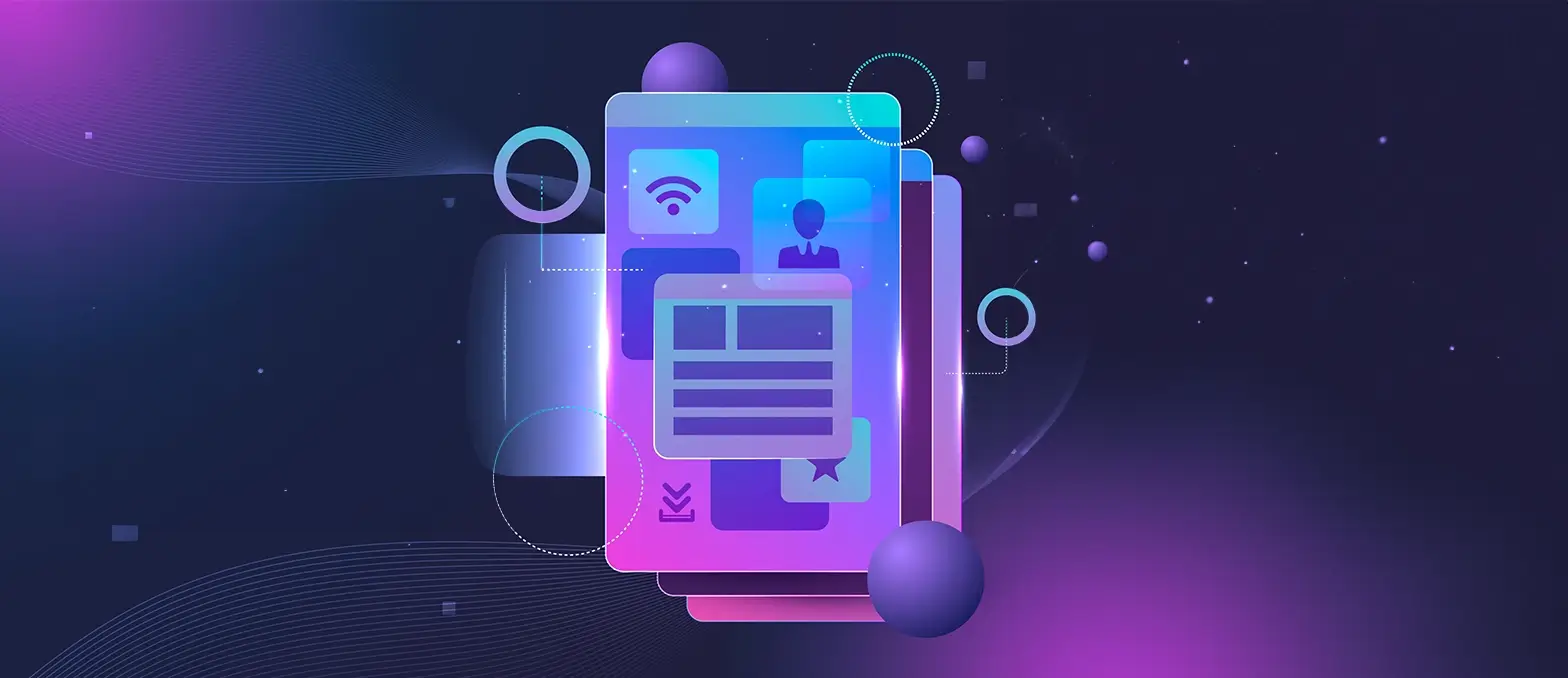Table of Contents
Mobile app developers have an integral role in our digital experiences in 2025. Statista data from 2022 shows that internet traffic from mobile devices currently makes up 58.99 percent of web traffic worldwide and 255 billion apps were downloaded overall from the free, paid, and subscription app market.
Throughout this blog, we will discuss the ways which mobile app developers technically shape a business value proposition in app design, development, and deployment so you can:
- Strategically invest in your custom application
- Interact with your customer base
- Cultivate a segment of your business that has tangible value
- Gain awareness of how an application that drives a positive customer experience with your brand looks like.
How the mobile app development principles of Experience and the User Interface are crucial to engagement at all times
Firstly, a review on the definitions of the User-Experience (UX) and the User Interface (UI) for mobile apps. UX and UI are fundamental to a well-conceptualized, well-tested, and well-deployed mobile app product. As design principles for app development, the UI is informed by the UX in order to achieve a seamless, user-friendly engagement. Interaction Design Foundation pinpoints this as, “UX design involves the design of the entire process of acquiring and integrating the product, including aspects of branding, design, usability and function.” Therefore while the two are inextricably related, the UX dovetails beyond the product’s usability to include the entire solution a brand is promising. This is explained more comprehensively by the Interaction Design Foundation as the development-oriented question, “How can we make the experience of interacting with a computer, a smartphone, a product, or a service as intuitive, smooth, and pleasant as possible?”
This naturally carries over to the objective of developing apps that engage users in a way that effortlessly nurtures the achievement of a value proposition. The UX and UI drive mobile app engagement to fulfil the value proposition of a service or product in several crucial ways. Foremost is on the theoretical level, wherein, according to Jeff Johnson of the Computer Science Department of the University of San Francisco, “A UX designer designs ideates, plans, changes the things that affect the user experience, perceptions and responses to a system or service.”
Second to this, yet still necessary, is the practical UX manifestation of the value proposition in the user’s desired functionalities features. This is where we see the indispensability of UX in fulfilling the value propositions of a brand in their app product.
Connecting the value proposition in mobile app development and design
Before our discussion of the technical features mobile developers use to uphold this in an app, we’ll review the differences between a Unique Selling Proposition and a Unique Value Proposition. These two areas of branding and business strategy do in fact have alternative definitions. The most-commonly referenced variant, the Unique Selling Proposition (USP) often also called a Unique Selling Point is centred on the overriding element or feature of a product or service that differentiates it from competitors. The USP concept originates from 1940s advertising with an emphasis on a proprietary process or technology that sets it apart.
On the other hand, a Unique Value Proposition (UVP) varies again due to the language and concepts tied to their application. It’s focus is on the qualitative and quantitative impacts of the product or service.
Role of UVP
We consider the UVP to most accurately represent the role of mobile apps for brands and their customers due to the dynamic nature of app usage:
- supporting existing products and resolving any problems,
- fulfilling customer service,
- providing user privacy and cybersecurity,
- experiencing the product or service, and,
- embodying a brand’s visual and business identity.
This far exceeds the traditional USP model to incorporate both the qualitative and quantitative characteristics of a UVP that are entirely synonymous with mobile apps.
Transferring the UVP concept into practice with mobile app design and development, a successful value proposition is even more urgent as to how reliant we are on mobile devices as the conduit of our internet experience. Start with revisiting and reinforcing the technical and design UX/UI features mobile app developers need to incorporate in every single app:
- Efficiency
- Reliability
- Clean design
- Simple language
- Accessibility
- Effortless navigation and logical flow between sections
- Agility
The objective for mobile developers to strategically integrate and incorporate the value proposition pillars into the UX/UI features. This is the key to nailing the UVP and entirely demonstrative of how mobile app developers shape the UX value proposition for your customers.
Differences between the unique value proposition on a service or product app
It’s relevant to address if there is any differences between a service or product app. If we were to solely focus on the abstract definition of a UVP, then there is no difference. In practice though, there are some divergences due to the fact that a service app may have external product-related features if it’s in support of goods or a facilitator for a paid experience whereas a product app will nearly always be standalone though it may have external product affiliations.
Below we’ll differentiate between the two categories to further explain how the UVP principle applies for mobile app developers depending on their development brief:
-
Service App
- This is characterized as Delivering an essential need in a new, better, and unique way that is valued by users.
- Examples: Uber, Bumble
-
Product App
- This is characterized as: Offering an entirely in-app experience that users are immersed in.
- Examples: Instagram
SaaS Applications
Software-as-a-Service (SaaS) applications. While nominally known as a ‘service’ this is misleading as the product design is an essential part of the app’s design. Also, the product features such as scaleability, agility, and customizability are part of what makes them valuable and robust. In fact, the UVP of SaaS is how they can be turned into mobile applications that diversify and increase the quality of the functionalities. The service feature refers to the provider of the software. Mobile applications have dominance over the desktop versions making the UVP of SaaS developed for mobile much more appealing to customers.
Key technical mobile application features to deliver on a unique value proposition
When developers are building a platform they are responsible for the technical infrastructure of every customer’s UX and the UVP the app exists to deliver. These aspects directly influence and shape the mobile user experience of every customer. Developers must encompass these three UX and associated UI elements:
-
Usability, accessibility, and navigation core features
Developers assist with hitting every component of the app UI to make an app perform in a crowded market. The UVP is substantiated through flawless and inclusive technical application features that make every moment of UX stand out against competitors. Bringing in the branding and functional aspects of usability (through a smooth, fast interface), accessibility (through color choices and clear design), and, navigation (through streamlined, logical app flow) all contribute to how your app will be received by users.
-
Value propositions shaped by the product or service features of the app
Users will prefer infrastructure that can swiftly and simply resolve any problems with minimal effort on their part. In the current era of apps, this kind of feature looks like artificial intelligence (AI) and machine-learning solutions.
-
Reinforce the value proposition in every component including testing and quality assurance
A thoroughly-tested application with an intuitive and usable UX/UI is part of a product being ready for launch on the App Store and Google Play. Part of preparing a Go-To Market strategy requires auditing, beta and A/B testing, and checking for bugs throughout the entire application. In case of missing of any steps during development, high chances are that the product launch will be without adequate assessments. As a result , it will lead to negative reviews and a bad look for the brand. Ultimately, this costs the company money for both its reputation and investment . Adhering to all steps of a development process are central to engineering a high-performing app and executing a UVP.
The app functionalities are entirely crucial in the fulfillment of the UVP so it makes sense to understand the common mistakes made in the development phase that compromise success with both product and service apps. Critically this is not about specific developer errors but more about the sequence and fulfilment of development steps.
Going to market with an app before completing A/B testing is a common error that buries a product. Stephanie Ross writes, “With Android apps, it’s only 2.6% after 30 days from installation, while the corresponding figure for iOS apps is 43%, according to Statista,”. So there is already a high bar for the app to meet with resounding delight and ongoing use from a market of millions.
If the decision has been made to invest in an entirely custom app designed to deliver a UVP then the following mistakes should be avoided at all costs
-
Lack of wide-reaching and specific research —
Understanding the competition and ensuring who the target audience is will be a valuable addition to the market. Clear definition of UVP and assurance of uniqueness also plays a crucial role.
-
Undefined target audience —
Narrowing down the target market and envisioning what the ideal user wants is achieved through research. The target market decides how you market the app, and how you produce something truly unique in a crowded business niche.
-
Rushing the development process including testing —
Failing to value and invest in these development steps will devalue the app before launch leading to waste of money. Therefore, taking the time to get it right will provide ROI after the deployment of app.
-
Not resolving bugs —
Not overcoming bugs that make a negative impression and lead to users discarding the app neglects your UVP. It’s tetchy and probably time-consuming but it’s attention-to-detail can correlate to five-star reviews.
-
Launching a slow, unresponsive, and cumbersome UI —
The only thing worse than a buggy UI is one that lacks modernity. The UI is what people think about an app and they will exit if the app is not satisfactory. Identifying and fixing the issues that detract from the UX in the UI delivers an impeccable and truly singular UVP.
-
Ignoring user feedback and not fulfilling UX/UI expectations —
Not properly investigating problems and user feedback also contributes to the UVP neglect.
-
Go-To Market strategy is poor —
Not conceptualizing and implementing a clear marketing and launch framework is a failure of the app owner. While connecting target users with an application is not the responsibility of the mobile app developer. This should feature in the conversations during the development process.
Conclusion
The role of mobile apps in both service and product value propositions are projected to sustain well. The customer experiences brands through the channels they interact with. This is an obvious takeaway of any discussion about stakeholder-oriented investment. It requires a clear understanding of target users, their needs, and the solutions delivered through the application.
Equally, getting the value proposition functionally and fruitfully embedded in the development takes time. Finding a team with a proven track record of producing robust products and process is essential. Lastly, remember that a value proposition is not a slogan or static branding. It’s a living part of what you are promising customers . It should be clearly defined while also practically upheld in all aspects of the app.






